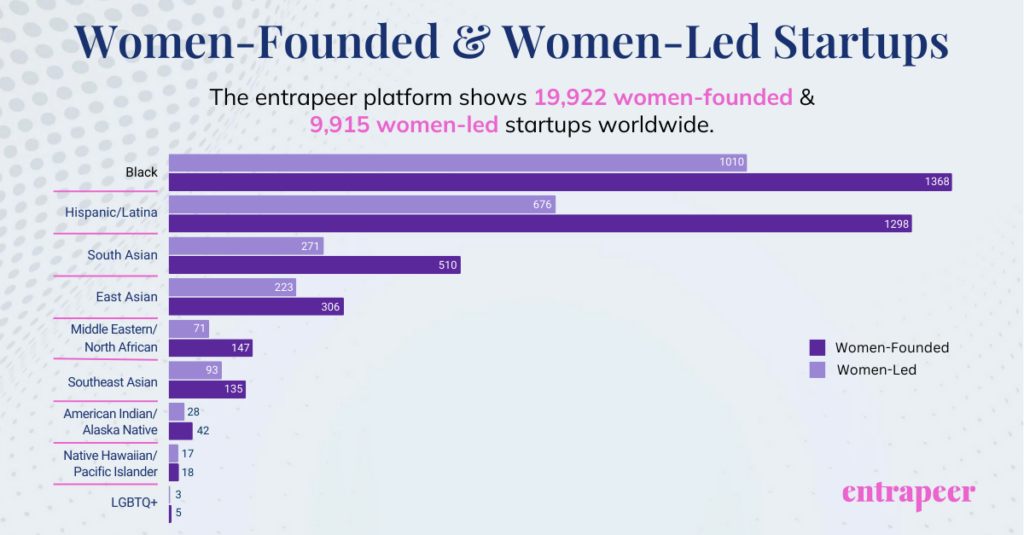
“We need to give each other space to grow, to be ourselves, to exercise our diversity. We need to give each other space so that we may both give and receive such beautiful things as ideas, openness, dignity, joy, healing, and inclusion.” ~ Maya Angelou
Entrapeer’s mission is to make innovation more accessible, actionable, and attainable than ever before. But what exactly do we mean by accessible?
We’ve talked at length about how our AI engine – entramind – strives to break down geographic, language, and culture barriers. Well, we believe that our innovation platform can transcend other social constructs – like gender – to level the playing field so innovators the world over can find success based solely on the merit of their ideas – not where they were born or how they identify.
We may be a small company, but we’re proud of the fact that almost half of our team (46% to be precise) identifies as women and women hold 43% of our leadership roles. That’s compared to the tech industry’s average of 35% and 28% respectively.
In celebration of International Women’s Day, we want to acknowledge the progress that’s been made in the past year when it comes to advancing women in technology. We also want to acknowledge the long road ahead, but with practical tips so we can all do our part to promote a more diverse and inclusive workplace.
After all, diversity is innovation because it’s only through the friction of diverse perspectives that new ideas are born.
So without further ado, let’s take a look at the numbers.
Women in Tech Jobs in 2024
A wave of change is rising, bringing with it a new era of female empowerment and diversity. Reports across the industry demonstrate a steady rise in women holding executive positions, with their sights set on domains traditionally dominated by men, such as automotive and oil & gas.
This emerging narrative underscores the indispensable value and unique perspectives that women contribute as leaders and innovators in technology. And while the number of women-led Fortune 500 businesses hit 52 last year (an all-time high), we celebrate with caution. There’s still a long road ahead – especially at the leadership level.
A 2023 study of 674 S&P 500 and Fortune 500 companies found that women represented 8.5% of sitting CEOs and 18.5% of CFOs, with luminaries like Oracle Corporation and AMD being the rare exceptions lighting the path forward. However, women of color are underrepresented at the leadership level.
Diving deeper, we witness a cautious rise in female representation, but the horizon is far from even. Presently, women constitute nearly half of the STEM workforce (about 35%) in the United States but hold only 28% of computing jobs. More troubling is the fact that 66% of women lack clear paths to career advancement and women are 1.6 times more likely to be fired than men.
When it comes to startup ownership, Statista estimates that only 20% of startups have at least one female founder. This comes as no surprise given startups’ reliance on a venture capital ecosystem that often bypasses women-led innovations. To illustrate: in 2022, startups with all-women teams received a mere 1.9% of the total venture capital allocated, highlighting a significant funding gap that affects the growth and visibility of women-owned tech businesses. This financial bottleneck stifles diversity at its source, perpetuating a cycle that sidelines potential breakthroughs.
Thankfully, that’s not the whole story. The global stage (and especially the US) is becoming more receptive to change, with women-led funds and mentorship initiatives gaining traction. These efforts are not just talking points but actionable plans making waves at international conferences and in the media, fostering a community that champions female empowerment in tech.
As we chart the progress in bridging the gender divide within tech, it’s clear that while strides have been made, the journey ahead remains substantial. The call to action is louder than ever; to not only spotlight but to actively dismantle the barriers that hinder equal representation and opportunity in the tech sphere. Let’s not just aim for improvement but leap towards transformation, ensuring that the tech industry becomes a beacon of inclusivity and diversity.
Current Landscape for Women-Owned Tech Companies
The entrapeer platform is by no means a complete picture but in our database, we registered 19,922 women-founded startups and 9915 women-led startups.
When we break this figure down even further to look at intersectional identities that factor in race or sexual orientation, we see the following:

The disparity between the number of women-founded startups and women-led startups can be attributed to several systemic challenges and biases within the venture capital and entrepreneurial ecosystems.
Firstly, despite the evidence showing that startups founded by women generate higher revenue per dollar invested compared to those founded by men, women-owned startups receive significantly less funding. Research conducted by the Boston Consulting Group (BCG) in partnership with MassChallenge found that investments in companies founded or co-founded by women averaged $935,000, which is less than half the average $2.1 million invested in companies founded by male entrepreneurs. Despite this stark disparity in funding, women-founded and co-founded startups were found to be more efficient in revenue generation, bringing in 10% more in cumulative revenue over five years compared to male-founded startups.
The reasons behind this funding gap are multifaceted. Hidden prejudices, gender bias, and a general lack of awareness within the venture capital industry contribute significantly. For instance, there’s a tendency for male VCs to be more comfortable investing in ventures that are perceived as aligned with traditional female interests, such as fashion or childcare, rather than in tech or other high-growth industries. This stereotyping extends to the belief that women do not found businesses in high-growth industries like technology, thereby affecting the types of ventures that receive support and visibility.
Another factor is the network effect, where women often lack the same level of access to networks and contacts as their male counterparts. This difference in networking opportunities can significantly impact the ability of women to raise funds. The entrepreneurial ecosystem’s structure, which often prioritizes connections and introductions, may inadvertently favor male-founded startups, which are more likely to have established networks within the venture capital community.
Addressing these disparities requires a concerted effort to diversify the types of startups considered for investment beyond those stereotypically associated with female entrepreneurs. It also calls for a broader cultural shift within the venture capital industry to recognize and address the unconscious biases that influence funding decisions. By fostering a more inclusive environment, the industry can not only achieve greater gender equality but also tap into the proven potential of women-led startups to deliver robust financial returns.
5 Trends Advancing Women in Technology

The landscape for women in tech jobs is undergoing a positive transformation, with several key trends fostering progress:
1. Rise of the Femtech Industry
The Femtech (female technology) sector, addressing women’s health and wellness needs through technology, is experiencing explosive growth. This industry, valued at over $1.1 billion in 2023, is creating opportunities for female entrepreneurs and investors, while tackling under-addressed medical issues impacting women.
What You Can Do: This trend may seem a bit niche, but no matter your industry, you can collaborate with femtech companies to enhance the medical benefits you offer women employees. Through partnerships, you can integrate advanced healthcare services like fertility support, personalized wellness programs, and mental health services, directly into your benefits offerings. This not only enriches your health benefits package but also demonstrates a commitment to addressing the unique health challenges and needs of women in the workforce.
2. Increased Investment in Women-Led Startups
Despite being underrepresented, women entrepreneurs – especially women of color – are making strides in gaining venture capital funding. In 2023, funding for women-led startups increased 57% as compared to the year prior, reaching record highs in 2023. However, we still have a long way to go.
What You Can Do: Built In urges women founders to leverage earned media to garner more media coverage and build reputations that make it impossible for VCs to ignore the waves women make.
3. Focus on Upskilling and Reskilling Programs
Leading tech companies are implementing targeted programs to equip women with the latest industry skills. These initiatives, like Google’s Women in Leadership program, aim to bridge the skills gap and propel women into leadership roles.
What You Can Do: To build our own upskilling or reskilling programs, start by conducting a comprehensive skills gap analysis to identify specific areas where women are underrepresented. Next, they should create accessible, flexible learning opportunities that cater to diverse schedules and life commitments, incorporating mentorship programs with female leaders to provide guidance and support. Finally, encouraging a culture of continuous learning and recognizing achievements in these programs can motivate participation and career advancement.
4. Growing Mentorship and Networking Opportunities
Organizations like Women’s Startup Lab, Women Who Code in the US, Arya in Turkiye, and AnitaB.Org, and Google’s programs for women founders are creating platforms for women in tech jobs to connect and share experiences. This fosters a sense of community, provides invaluable mentorship, and empowers women to navigate the tech landscape effectively.
What You Can Do: Even if your organization cannot build a program to serve and support women, you can still prove a valuable resource for women seeking such communities. Include such resources in your onboarding materials. Partner with external organizations to offer broader mentorship access. Organize internal networking events with guest speakers and facilitate access to digital platforms dedicated to professional growth. There are countless creative ways you can tap into the existing infrastructure to empower women within your organization.
5. Flexible Work Environments
Data shows that remote work is a win-win for everyone. However, it’s especially beneficial for women – and not just because they can spend more time with their kids. Women report increased ambition, better mental health, fewer microaggressions, and countless other benefits as a result of more flexible work models. This flexibility is critical for retaining talented women who manage professional and personal responsibilities.
What You Can Do: To offer flexible work plans that benefit everyone – but especially women and marginalized groups – prioritize creating policies that support remote and hybrid work models. Of equal importance: ensure that remote workers have access to necessary technology and resources no matter where they’re working from.
6. Evolving Workplace Culture
Recent news would have you believe that DEI initiatives are flagging due to backlash, but the evidence tells a different story. In fact, in the 2023 Women in the Workplace report, 60% of respondents reported increasing DEI budgets over the past year. What’s more, LinkedIn ranked VP of diversity and inclusion as the 7th fastest-growing job in the U.S. over the past five years. In short: DEI isn’t going anywhere.
What You Can Do: Start by committing to a holistic diversity, equity, and inclusion strategy that will be your company’s north star. But don’t just Google best practices – bring in an expert. Hire an outside consultant to assess your needs and propose a path forward to avoid any inherent bias or conflicts of interest.
Looking Forward
So what’s next?
Well, for our part, entrapeer plans to release a new feature to champion female founders and women-led startups very soon. Follow us on LinkedIn and Twitter to stay up to date on the latest platform developments.
As for you, we urge you to ask yourself and your team:
- Are we fostering an inclusive and equitable work environment for all genders (and identities more broadly)?
- Are we actively investing in the mentorship and advancement of women in our workforce?
- Are we holding ourselves accountable for measurable progress toward gender diversity and inclusion in leadership roles?
By critically evaluating your answers to these questions, you can identify areas of strength and opportunities for improvement in advancing women in technology.
We’ll leave you with this, by no means comprehensive, list of resources for women founders and women in tech more broadly. Happy International Women’s Day!
23 Resources for Women Founders and Women in Tech
The landscape for women in tech is constantly evolving, and there are numerous resources available to support and empower them. Here’s a list of 25 resources across various categories:
Funding & Investment:
- Amber Grant: An annual grant competition awarding $1 million in prize money to women-owned businesses in the United States.
- Astia: A non-profit organization that invests in women-led startups in high-growth industries globally.
- Woman-Owned Business Grants: SBA helps women entrepreneurs launch new businesses and compete in the marketplace. Connect with the training and funding opportunities specifically for women.
- More US-Based business grants
- EY Entrepreneurial Winning Women™ Mergelane Accelerator Program: A 12-week program providing mentorship, funding, and networking opportunities for female entrepreneurs.
- Plum Alley: A venture capital firm focused on investing in women-led healthcare and life sciences companies.
- Female Founders Fund: A venture capital firm investing in early-stage, women-led technology companies.
- Women Startup Lab: A global accelerator program providing mentorship, funding, and networking opportunities for women entrepreneurs.
Advocacy, Education & Networking:
- The BOSS Network: A global women’s empowerment organization providing resources, events, and networking opportunities for professional women.
- Dell Women’s Entrepreneur Network: A global community for women entrepreneurs providing access to resources, mentorship, and networking opportunities.
- Ellevate Network: A global organization for professional women providing leadership development programs, networking opportunities, and resources.
- Chief: The private network executive women rely on to maximize their leadership impact through access to a vetted executive community and valuable insights.
- National Women’s Business Council: A U.S. council advocating for policies and programs to support women entrepreneurs.
- Savor the Success: A platform providing resources, events, and mentorship opportunities for women entrepreneurs.
- SBA’s Office of Women’s Business Ownership: A U.S. government agency providing resources and programs to support women entrepreneurs.
- WEConnect International: A global organization connecting women-owned businesses with multinational buyers.
- Women Impacting Public Policy: A bipartisan organization advocating for policies that empower women.
- The Vinetta Project: A non-profit organization providing resources and support to women in tech, particularly in leadership roles.
Mentorship & Skill Development:
- Girls in Tech: A global organization providing coding classes, workshops, and hackathons for girls and women of all ages.
- Lean In Circles: A global community providing peer support and mentorship opportunities for women.
- She Breaks Barriers: A platform connecting women with mentors and resources to help them advance their careers in tech.
- Technovation Girls: A global tech competition for girls aged 10-18, encouraging them to solve real-world problems using technology.
- Women Who Code: A global non-profit organization providing coding education and mentorship opportunities for women.

